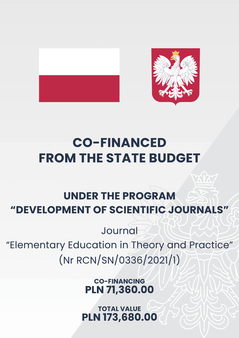Introduction
Abstract
The latest issue of “Elementary Education in Theory and Practice” is devoted to the pedagogical thought of Maria Montessori, one of the greatest innovators of 20th century education. Her pedagogical concepts, although designed over 100 years ago, seem to carry an unusual freshness, originality and intellectual depth, inspiring new generations of teachers, researchers and parents. As Clara Tornar has noticed, the unique cognitive potential of this pedagogy is based on interrelations between the method of scientific observation and its consequent development and improvement, based on rigidly precise scientific criteria – rationality and objectivity. M. Montessori perceived the classroom learning environment as an exclusive “psychological laboratory”. Not from the behaviourist perspective, however, not as a place where, in rigorously controlled conditions, a researcher is activating a stimulus to induce the proper, preplanned and expected reaction of the child. On the contrary, her vision of a psychological laboratory built and practiced in Casa dei Bambini was based on three cyclical phases, representing the methodology of research in action:
designing a learning environment prepared for exercising free choice – the place for empowering the child, triggering the free expression of the child’s psychological needs, inner potential and developmental tendencies;
methodically observing the child’s reactions to this environment and the conditions for free action;
and, finally, reorganizing and transforming this environment to make it serve better to the observed needs and possibilities of the child, to make the stimuli included in this environment facilitators for the child’s development, for constructing his/her own developmental potential.
Copyright (c) 2018 Elementary Education in Theory and Practice

This work is licensed under a Creative Commons Attribution-NoDerivatives 4.0 International License.
- When submitting a text, the author declares that he/she is the Author of the article (hereinafter referred to as the “Work”) and:
- he/she owns the exclusive and unlimited copyright to the Work,
- is entitled to dispose of the copyright to the Work.
Declares that it does not infringe any third party copyrights or legal rights.
Declares that there is no conflict of interest.
2. At the same time, the Author grants the Ignatianum University in Cracowa royalty-free, non-exclusive and territorially unlimited licence to use the Work in the following fields of exploitation:
- recording the Work in a hard copy, as well as on a digital or magnetic medium;
- reproduction of the Work using any technique, without limitation of the number of editions or copies;
- distribution of the Work and its copies on any medium, including marketing, sale, lending, and rental;
- introduction of the Work into a computer memory;
- disseminating the Work in information networks, including in the Internet;
- public performance, exhibition, display, reproduction, broadcasting and re-broadcasting, as well as making the Work available to the public in such a way that everyone can have access to it at a time and place of their own choosing;
- within the scope of dependent rights to the Work, including in particular the right to make necessary changes to the Work resulting from editorial and methodical development, as well as to translate the Work into foreign languages;
The licence is granted from the moment of the transfer of the Work to the Ignatianum University in Cracow. The Ignatianum University in Cracow is entitled to grant further sub-licences to the Work within the scope of the right granted. The licence is time-limited and it is granted for a period of 15 years, starting from the date of its granting.
Authors are permitted and encouraged to publish their text online (e.g. in their institution’s repository or on the institution’s website) before or during the submission process as this may lead to beneficial exchanges, as well as earlier and greater citation of the published text (See The Effect of Open Access). We recommend using any of the following portals of research associations:
- ResearchGate
- SSRN
- Academia.edu
- Selected Works
- Academic Search





